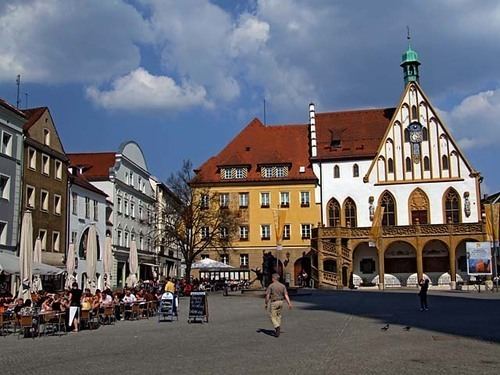Admin. region Oberpfalz Time zone CET/CEST (UTC+1/+2) Local time Tuesday 5:57 AM Postal code 92224 | District Urban district Postal codes 92224 Population 44,059 (31 Dec 2008) | |
 | ||
Weather 4°C, Wind W at 14 km/h, 82% Humidity University University of Applied Sciences Amberg-Weiden | ||
Amberg ( [ˈambɛrk]) is a town in Bavaria, Germany. It is located in the Upper Palatinate, roughly halfway between Regensburg and Bayreuth. In 2013, over 41,000 people lived in the town.
Contents
- Map of Amberg Germany
- History
- Jewish History
- Lord mayors
- Population development
- Sights
- International relations
- Notable people
- References
Map of Amberg, Germany
History
The town was first mentioned in 1034, at that time under the name Ammenberg. It became an important trading centre in the Middle Ages, exporting mainly iron ore and iron products. In 1269, together with Bamberg, the town became subordinate to the Wittelsbach dynasty that ruled Bavaria.
In 1329 the town and the entire Upper Palatinate fell to a branch line of the Wittelsbach family and was no longer part of the duchy of Bavaria. Although in geographic terms it was regarded as Bavarian and the region was part of the Bavarian circle in the organization of the Imperial Circles. The rulers of Upper Palatinate were open-minded towards Protestantism. In the 16th century the town turned to Lutheranism, but attempts of the ruling family to introduce the more radical Calvinism failed due to the reluctance of its citizens.
In 1628 Amberg and Upper Palatinate became part of the electorate of Bavaria. The inhabitants were given the choice: return to Catholicism or leave the town forever. Many families left the town and fled to the Free Imperial Cities of Regensburg and Nuremberg.
On 24 August 1796, during the French Revolutionary Wars, the city and its environs were the locale of a major battle at which 35,000 French, under the command of Jean Baptiste Jourdan fought with 40,000 Austrians under the command of Archduke Charles; the French suffered significantly more losses in this Austrian victory. Amberg was the regional capital of Upper Palatinate until 1810 when power was transferred to the larger city of Regensburg.
After World War II, when Bavaria fell into the American Sector, Amberg was home to Pond Barracks, a United States Army post. I.F.Stone writes about it in his book Underground to Palestine (pp. 31ff). The post was closed in 1992 and the facility turned over to the local community for housing, most of it for social housing.
Jewish History
Jews had settled in Amberg before 1294, when the first documentation can be found. Shortly after, in 1298, thirteen of the town Jews died during the Rindfleisch massacres. Nevertheless, in 1347 six families received permission to settle in Amberg and twenty years after, in 1367, a Yeshivah was opened in it, though the Jewish community was expelled from Amberg in 1403. Upon the expulsion, the synagogue was annexed to the nearby church. Twelve Jews remained in town in 1942. The few survivors returned to the town after 1945, and a displaced persons camp named Amberg - located nearby the town - housed mostly Jewish refugees and survivors. As a result of immigration from the former USSR to Germany, the Jewish population in town grew to about 275 in 2003. A synagogue exists in town nowadays.
Lord mayors
Population development
Data source:
Sights
A defining feature of the town is the Stadtbrille (literally: town spectacles) – a bridge, originally a part of the town fortifications, whose arches reflected on the river waters resemble a pair of spectacles.
Other tourist attractions in Amberg include:
International relations
Amberg is twinned with:
